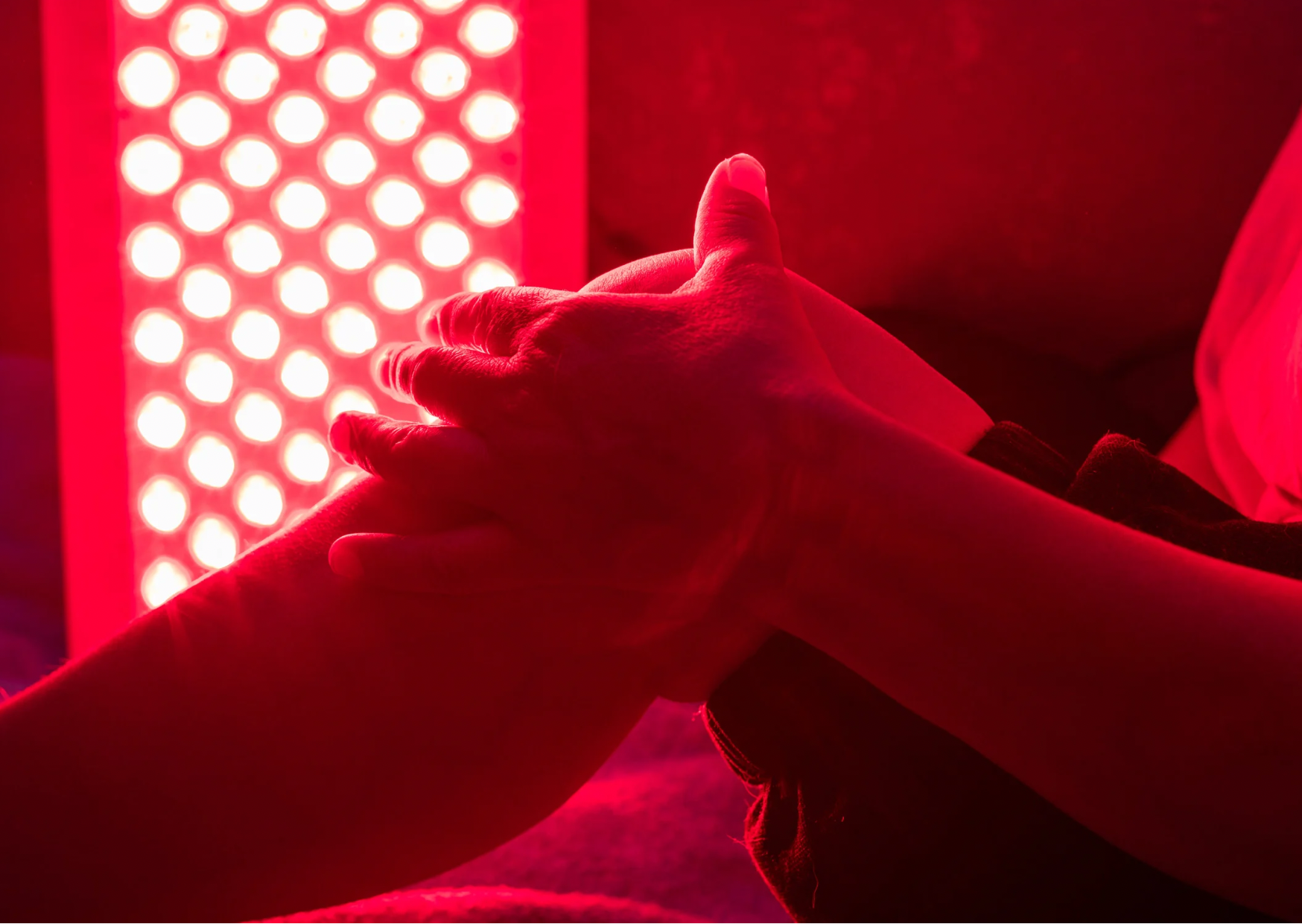Feeling less energetic at this time of year?
As the low sun plays hide-and-seek, our body clock is left confused by the lack of sunlight and the abundance of artificial lights at the wrong times.
It’s tempting to accept low energy as a winter norm, but don’t give up just yet—there’s a light on the horizon! We’ve delved into scientific research to offer you strategies to revitalize your energy levels.
Why Does Our Energy Take A Nosedive In The Winter?
Just like plants need light to grow, our cells also need light to be able to function optimally (more on this later). Bright sunny days are rare in the winter, PLUS we often prefer to stay cozied up inside avoiding the winter chill, meaning we skip out on our dose of sunshine. Our whole body is affected; poor light exposure causes misaligned circadian rhythms, impacting our sleep, mood, digestion, energy, focus, and more.
Beyond Light: Other Causes of Fatigue
In addition to a lack of light, factors such as anemia, nutrient deficiencies, hormonal imbalances, infections, stress, and insufficient physical activity can all contribute to persistent fatigue, regardless of the season. It’s important to consult a doctor to identify the underlying causes and get appropriate treatment.
Note: This article is not meant to serve as medical advice.

The Powerhouse of Energy in our Bodies
You probably learned in middle school that the mitochondria are the powerhouse of the cell, but what does this mean for our well-being?
All over our body, cells use oxygen, food, and water to create energy in the form of ATP. This job is mainly done by the mitochondria that churn out ATP.
ATP powers everything we do, from running and walking to thinking, feeling, digesting food, healing wounds, growing hair… and so much more.
Efficiency is key: the faster our cells can make and use this energy, the better our body works on the inside, and the better we feel on the outside!
The Magic of Light
Now, here's something intriguing: a process you might think only helps plants also occurs in the human body. Just as light is essential for photosynthesis in plants, it also powers up the mitochondria in our cells.
Without light, our mitochondria function at a mediocre level at best. However, a little light goes a long way; even on a gray day, there's still an ample amount – over 10,000 lux. 'Lux' is a way to measure how bright a light looks to our eyes, essentially indicating the amount of light in a given area.
This might explain why some people get an energy boost when they go outdoors!
Let’s Talk Red Light
Exercise, sleep, vitamins, stress management - we’ve heard it all before, but even when you think you’ve done it all right, there can be those days when our energy levels don’t show up for us.
Emerging research suggests that red light therapy, an innovative tool that supports cellular energy production, could be the mitochondria's new best friend.
The Science: Red Light for Energy Support
How does light power up the mitochondria?
Let’s take a closer look inside the cell. Each cell contains hundreds to thousands of tiny mitochondria, and within each one is an enzyme called cytochrome c oxidase. This enzyme absorbs specific wavelengths of red and near-infrared light [2], which activates a process that prompts the mitochondria to produce more ATP (energy) for the cell. [1, 4]

So, RED and NIR light may increase the rate of ATP formation [5], which is necessary to energize all bodily processes!
Tests on isolated rat liver mitochondria show that wavelengths in the red light spectrum increased ATP synthesis and oxygen consumption [3]. Blue and green light wavelengths did not influence the rate of this process.
Have we seen results play out on humans?
Take, for instance, this randomized clinical trial on 20 patients with Fibromyalgia. [7] Fatigue is a cornerstone symptom of Fibromyalgia, a disorder partly caused by inflammation in the brain [6]. When red laser light (670 nm, 570 mW/cm²) was applied to various tender points such as the lower neck, base of the skull, and joints (knees, hips, and elbows), patients reported significant improvements in symptoms of fatigue, depression, anxiety, and physical impairment. This is a very high irradiance though, so we are not saying this could be reproducible using LED-based red light therapy - but worth checking with your doctor.
Combatting The Lesser-Known Energy Zappers Using Red Light
Combatting the Effects of NO Buildup.
Energy levels are dampened by plastics and heavy metals in our food and products, artificial light at night, air pollution, and a life full of stressors… all causing nitric oxide (NO) to build up in our cells.
According to Dr. Hamblin, NO reduces the production of ATP in the mitochondria [8]. As more NO builds up, it hinders cytochrome c oxidase (the enzyme helping out the mitochondria) from working as well. This reduction in ATP means our cells don't produce energy as efficiently as they should.
However, red and near-infrared (NIR) light therapy offers a promising approach. These specific wavelengths of light have been shown to prevent nitric oxide (NO) from disrupting cytochrome c oxidase's role in ATP production [9]. This allows essential pathways for energy production to continue, helping our cells function optimally and supporting overall energy levels.
Red light may support a healthy mood.
Dips in mood can sneakily zap our usual get-up-and-go energy. Mood fluctuations, particularly anxiety and depression, are linked to factors like decreased brain activity [10], poor blood flow [11], stress [12], and inflammation [13].
Studies delivering near-infrared light to the head have reported observed antidepressant effects in patients with major depressive disorder (MDD), evidenced by reductions in the Hamilton Depression Rating Scale (HAM-D17) scores [14].
And guess what? If your mood is lifted by this light, your energy levels may follow!
Red light is great for balancing our stress hormones.
Cortisol, often referred to as the "stress hormone," is released by the adrenal glands in response to stress. While cortisol helps the body manage stress in the short term, prolonged elevated levels can disrupt sleep, reduce energy levels, and impair overall well-being. This hormonal imbalance contributes to the fatigue and constant tiredness commonly associated with chronic stress [15].
Red light may result in smaller increases in cortisol compared to blue or white light, particularly during sensitive periods like early morning [21].
Swapping red light for blue light from screens or bright white light from overhead lighting before bed is a great way to support natural rest. Here’s a simple hack to make the switch!
Red light may help balance blood sugar.
Another example of how you can harness the power of red light to tap into those energy reserves is by managing steep rises and falls in blood sugar!
Our energy levels throughout the day are strongly tied to glucose regulation [17, 18]. The more stressed we are, the more our glucose levels fluctuate [19]. A recent University College London study showed that when shone on the back of 15 people, red LED light significantly reduced blood glucose levels in clinical tests. “When comparing red light against placebo interventions, 670 nm light reduced the elevation in blood glucose by 27.7% over the 2 hours of fasting oral glucose tolerance tests”. [20]
Note: this study was published recently (2023) and has not been extensively peer-reviewed.
Red light can help us rest up.
We all know that poor sleep makes combatting tiredness an uphill battle.
We have a blog post HERE on sleep with valuable tips to help you use red light therapy to your advantage!
Of course, there are MANY more energy zappers out there too!
5 Easy Lifestyle Tips To Improve Daily Energy
1. See your doctor about underlying medical conditions such as anemia, thyroid conditions, or nutrient deficiencies like vitamin B-12, which are often behind fatigue. Laboratory tests can confirm these.
P.S. Keep in mind that consuming nutrients doesn't guarantee absorption; for instance, low stomach acid can hinder B-12 absorption from meat. Working with your doctor for proper diagnosis and lab tests is crucial.
2. Prioritize your sleep sanctuary! Deep, restorative sleep is crucial for rejuvenating your brain and body overnight, allowing you to reserve your daytime energy for life's other demands.
3. Avoid sugary foods - these may temporarily give you a rush, but may cause energy slumps when your blood sugar plummets. A consistently raised blood sugar can also contribute to inflammation. Instead, try to maintain balanced blood sugar by incorporating carbohydrates paired with fiber, protein, and fats. This will ease the impact of quick-releasing energy that can otherwise send your blood sugar on a rollercoaster (which your energy levels will mirror).
4. Embrace gentle movement – If you're feeling very tired, movement might be the last thing on your mind but something as simple as a walk can start to kick the mitochondria into gear. Zone 2 training works wonders for mitochondrial health, and strength training helps maintain a healthy blood sugar balance.
5. Add red light therapy - we love a red light therapy session first thing in the morning to start our day on a bright and positive note. Use it to tame inflammation, a hidden culprit behind energy dips.
The energy you radiate starts from within – embrace each day to recharge and revitalize your inner reserves!
References:
- Osborne, N. N., Núñez-Álvarez, C., Del Olmo-Aguado, S., & Merrayo-Lloves, J. (2017). Visual light effects on mitochondria: The potential implications in relation to glaucoma. Mitochondrion, 36, 29–35. https://doi.org/10.1016/j.mito.2016.11.009
- Hamblin M. R. (2016). Shining light on the head: Photobiomodulation for brain disorders. BBA clinical, 6, 113–124. https://doi.org/10.1016/j.bbacli.2016.09.002
- Karu T. (1999). Primary and secondary mechanisms of action of visible to near-IR radiation on cells. Journal of photochemistry and photobiology. B, Biology, 49(1), 1–17. https://doi.org/10.1016/S1011-1344(98)00219-X
- Ferraresi, C., Kaippert, B., Avci, P., Huang, Y. Y., de Sousa, M. V., Bagnato, V. S., Parizotto, N. A., & Hamblin, M. R. (2015). Low-level laser (light) therapy increases mitochondrial membrane potential and ATP synthesis in C2C12 myotubes with a peak response at 3-6 h. Photochemistry and photobiology, 91(2), 411–416. https://doi.org/10.1111/php.12397
- Osborne, N. N., Núñez-Álvarez, C., Del Olmo-Aguado, S., & Merrayo-Lloves, J. (2017). Visual light effects on mitochondria: The potential implications in relation to glaucoma. Mitochondrion, 36, 29–35. https://doi.org/10.1016/j.mito.2016.11.009
- Wolfe F, Ross K, Anderson J, Russel IJ, Hebert L (1995) The prevalence and characteristics of fibromyalgia in the general population. Arthritis Rheum 38(1):19–28. doi:10.1002/art.1780380104
- Ruaro, J. A., Fréz, A. R., Ruaro, M. B., & Nicolau, R. A. (2014). Low-level laser therapy to treat fibromyalgia. Lasers in medical science, 29(6), 1815–1819. https://doi.org/10.1007/s10103-014-1566-8
- Hamblin, M. (2008). The role of nitric oxide in low level light therapy. In Proceedings of SPIE - The International Society for Optical Engineering, 6846. The International Society for Optical Engineering. https://doi.org/10.1117/12.764918
- Hamblin, M. (2008). The role of nitric oxide in low level light therapy. In Proceedings of SPIE - The International Society for Optical Engineering, 6846. The International Society for Optical Engineering. https://doi.org/10.1117/12.764918
- Iosifescu, D.V., Bolo, N.R., Nierenberg, A.A., Jensen, J.E., Fava, M., and Renshaw, P.F. (2008). Brain bioenergetics and response to triiodothyronine augmentation in major depressive disorder. Biol. Psychiatry 63, 1127–1134.10.1016/j.biopsych.2007.11.020
- Videbech, P. (2000). PET measurements of brain glucose metabolism and blood flow in major depressive disorder: a critical review. Acta Psychiatr. Scand. 101, 11–20.10.1034/j.1600-0447.2000.101001011.x
- Gawryluk, J.W., Wang, J.-F., Andreazza, A.C., Shao, L., and Young, L.T. (2011). Decreased levels of glutathione, the major brain antioxidant, in post-mortem prefrontal cortex from patients with psychiatric disorders. Int. J. Neuropsychopharmacol. 14, 123–130.
- Zunszain, P.A., Hepgul, N., and Pariante, C.M. (2012). Inflammation and depression. Behavioral Neurobiology of Depression and Its Treatment. (Berlin Heidelberg: Springer), pp. 135–151.10.1007/7854_2012_211
- Cassano P, Petrie SR, et al. Transcranial Photobiomodulation for the Treatment of Major Depressive Disorder. The ELATED-2 Pilot Trial. Photomedicine and Laser Surgery. 2018 October.
- Doedee, F., van den Houdt, S., Widdershoven, J., & Kupper, N. (2021). Chronic stress exposure in men and women, and implications for the course of fatigue after percutaneous coronary intervention; the THORESCI study. General Hospital Psychiatry. https://doi.org/10.1016/j.genhosppsych.2021.07.001
- Odinokov, D., & Hamblin, M. R. (2018). Aging of lymphoid organs: Can photobiomodulation reverse age-associated thymic involution via stimulation of extrapineal melatonin synthesis and bone marrow stem cells? Journal of Biophotonics. Advance online publication. https://doi.org/10.1002/jbio.201700282
- Zhou, Z., Sun, B., Huang, S. et al. Glycemic variability: adverse clinical outcomes and how to improve it?. Cardiovasc Diabetol 19, 102 (2020). https://doi.org/10.1186/s12933-020-01085-6
- Antonio Ceriello, Katherine Esposito, Ludovica Piconi, Michael A. Ihnat, Jessica E. Thorpe, Roberto Testa, Massimo Boemi, Dario Giugliano; Oscillating Glucose Is More Deleterious to Endothelial Function and Oxidative Stress Than Mean Glucose in Normal and Type 2 Diabetic Patients. Diabetes 1 May 2008; 57 (5): 1349–1354. https://doi.org/10.2337/db08-0063
- Mason JW. A review of psychoendocrine research on the pituitary-adrenal cortical system. Psychosom Med 1968;30(5):576–607.TRANSCRANIAL LOW-LEVEL LASER THERAPY IMPROVES DEPRESSION705
- Powner, M. B., & Jeffery, G. (2023). Optical stimulation of mitochondria reduces blood glucose levels. Preprint. https://doi.org/10.21203/rs.3.rs-3275287/v1
- Robertson-Dixon I, Murphy MJ, Crewther SG, Riddell N. The Influence of Light Wavelength on Human HPA Axis Rhythms: A Systematic Review. Life (Basel). 2023 Sep 26;13(10):1968. doi: 10.3390/life13101968. PMID: 37895351; PMCID: PMC10608196.




